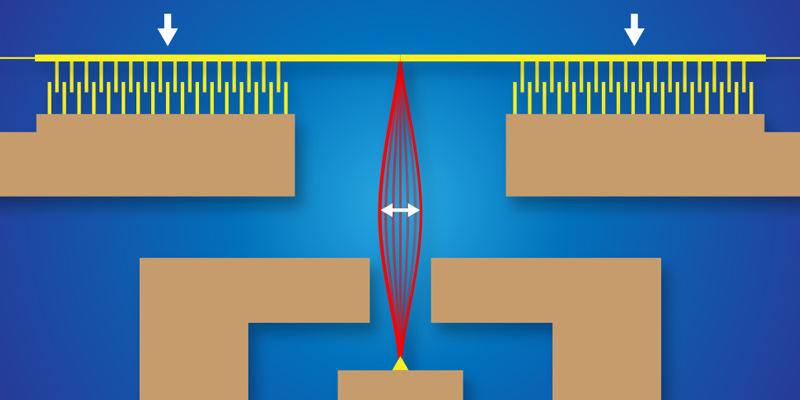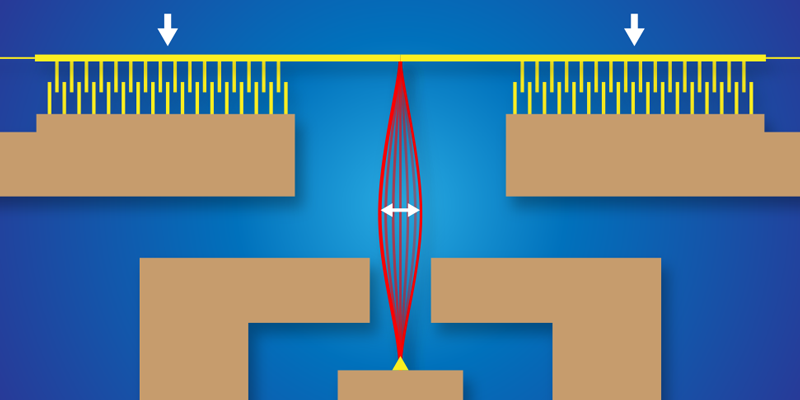Buckling on Command
The buckling of a column or other structural element is typically something that engineers want to avoid, but a new device offers a way to control this type of deformation on microscopic scales. The design combines small actuators and circuits that generate mechanical and electrostatic forces on a nanoscale beam, causing it to buckle to the left or to the right. By manipulating the beam’s deformation, researchers may be able to harness buckling for sensitive detectors or for testing the relationship between thermodynamics and computing.
Buckling occurs when a compressive force is applied to the ends of a thin structural component, causing it to bend outwards in the middle. In civil engineering, buckling is a curse word, as it often leads to mechanical failure. However, it can play an important role in nanoelectromechanical systems (NEMS)—devices that combine electronic components like transistors with nanoscale motors, pumps, or mechanical actuators. In NEMS, the buckling of a nanoscale piece could be used to weigh a small mass, to measure acceleration, or to build electromechanical relays. Buckling could also provide a way to store information in mechanical bits that have two structural states, such as “buckled left” for 1 and “buckled right” for 0. These buckling bits could be part of future nanomechanical computers, which have the potential to be more robust and energy-efficient than electronics-based computers.
Studying buckling in controlled and repeatable experiments, however, is no easy feat, in particular for micrometer- and nanometer-sized objects. Some previous studies caused buckling by pre-stressing a beam during the fabrication process, but this approach is irreversible and doesn’t allow control of the buckling. Other studies have induced buckling by heating, but the required temperature increases—tens of degrees kelvin—wouldn’t be suitable for real devices.
For their new device, a team led by Selim Hanay of Bilkent University in Ankara, Turkey, exploited purely electrostatic effects to control a beam’s buckling—including the direction and amount of deformation—without significant heat generation. They started by fabricating a 40-micrometer-long, 150-nanometer-wide silicon beam that they placed between a static metal “floor” and a moveable “ceiling” controlled by an actuator called a comb drive. When a voltage was applied to this actuator, two comb-shaped structures were pulled together, resulting in a lowering of the ceiling that compressed the beam. The compression caused the beam to buckle, with the middle of the beam curving away from the axis by as much as 12% of the beam length.
The researchers manipulated the direction of the buckling using electronic gates placed on either side of the beam. The gates produced a lateral electrostatic force that pulled the beam to the left or the right, depending on the applied voltage. The team recorded this behavior with a scanning electron microscope (see video).
The researchers showed that they could induce a sudden transition between the leftward- and rightward-buckled configurations. Such a “snap-through” transition, which is reminiscent of what happens when an umbrella is inverted by a gust of wind, has potential applications in shape-shifting materials or mechanical pumps for people with certain heart conditions. The experimental setup “could help in answering many open questions about this transition—like what controls its speed,” says applied mathematician Dominic Vella of the University of Oxford in the UK.
Besides opening new avenues for applied research, the nanobeam setup could also be used to study the thermodynamics of information, Hanay says. Specifically, he plans to apply the setup to test Landauer’s principle, which gives a lower limit on the energy cost per computation. The principle could be tested by storing a bit in one of the two stable states of the beam and measuring the heat generated when the bit of information is erased. Similar tests have been carried out before, but Hanay says that his team’s setup could provide a more precise accounting of how the entropy changes in the system.
Peter Grutter, an experimental physicist at McGill University in Montreal, says the scheme is “a technological breakthrough” obtained through a creative trick. “Comb drives are popular devices for moving microscopic components, but no one had thought of using them to apply strain,” he says. Theorist Fabio Pistolesi of the University of Bordeaux and CNRS in France says that the “exquisite control of buckling” could be harnessed in applications like accelerometers and in fundamental studies of nonlinear mechanics on these small scales.
This research is published in Physical Review Letters.
–Matteo Rini
Matteo Rini is the Editor of Physics Magazine.





